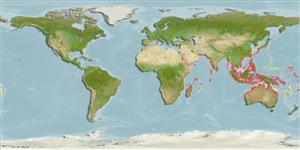Common names from other countries
Environment: milieu / climate zone / depth range / distribution range
Sinh thái học
Biển; Thuộc về nước lợ Sống nổi và đáy. Tropical; 35°N - 37°S, 20°E - 178°W
Indo-Pacific: Persian Gulf to Fiji and north to Japan. Known from Delagoa Bay, Mozambique and Suez Canal on the African coast. Western Atlantic: introduced at Trinidad and Panama Canal near Atlantic end (Ref. 26938).
Bộ gần gũi / Khối lượng (Trọng lượng) / Age
Maturity: Lm ? range ? - ? cm
Max length : 9.5 cm SL con đực/không giới tính; (Ref. 4404); Tuổi cực đại được báo cáo: 4 các năm (Ref. 11441)
Các tia vây lưng cứng (tổng cộng) : 11 - 13; Các vây lưng mềm (tổng cộng) : 19 - 24; Tia cứng vây hậu môn: 2; Tia mềm vây hậu môn: 20 - 26. Head without cirri and crest. Lower end of gill opening opposite upper margin of pectoral fin. Sensory pores in infraorbital and interorbital canals mostly 8 and 3 respectively. Lateral line usually 7 to 11. Horizontal stripes on body distinct in male, but somewhat obscure in female.
Adults occur in coastal and brackish waters among rocks and mangroves (Ref. 9710). Oviparous. Eggs are demersal and adhesive (Ref. 205), and are attached to the substrate via a filamentous, adhesive pad or pedestal (Ref. 94114). Larvae are planktonic, often found in shallow, coastal waters (Ref. 94114). Highly tolerant to adverse environmental conditions, self-reproducing population living between rocks in natural oil seeps in Venezuela (Ref. 56126).
Life cycle and mating behavior
Maturities | Sự tái sinh sản | Spawnings | Egg(s) | Fecundities | Ấu trùng
Oviparous, distinct pairing (Ref. 205).
Springer, V.G., 1986. Blenniidae. p. 742-755. In M.M. Smith and P.C. Heemstra (eds.) Smiths' sea fishes. Springer-Verlag, Berlin. (Ref. 4404)
IUCN Red List Status (Ref. 130435)
CITES (Ref. 128078)
Not Evaluated
Threat to humans
Harmless
Human uses
Các nghề cá: không ích lợi (thú vị)
Các công cụ
Special reports
Download XML
Các nguồn internet
Estimates based on models
Preferred temperature (Ref.
115969): 24.7 - 29.1, mean 28.4 (based on 2724 cells).
Phylogenetic diversity index (Ref.
82804): PD
50 = 0.5000 [Uniqueness, from 0.5 = low to 2.0 = high].
Bayesian length-weight: a=0.00741 (0.00410 - 0.01339), b=3.09 (2.92 - 3.26), in cm Total Length, based on LWR estimates for this species & (Sub)family-body (Ref.
93245).
Mức dinh dưỡng (Ref.
69278): 2.5 ±0.1 se; based on size and trophs of closest relatives
Thích nghi nhanh (Ref.
120179): Trung bình, thời gian nhân đôi của chủng quần tối thiểu là 1.4 - 4.4 năm (tmax=4).
Fishing Vulnerability (Ref.
59153): Low vulnerability (10 of 100).
